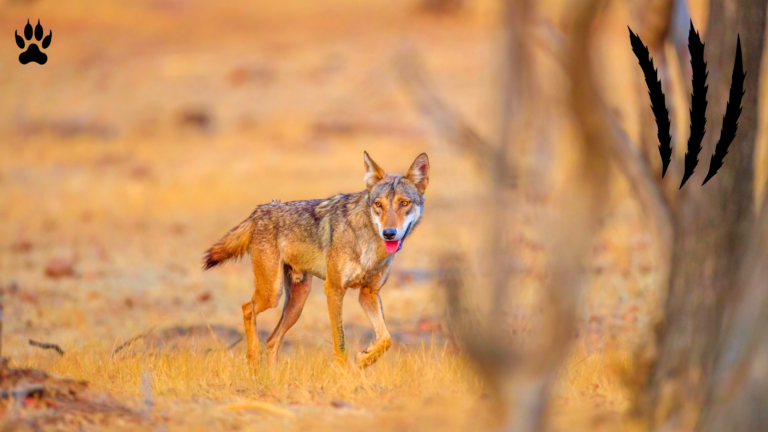भारत में जब भी जंगली जानवरों की बात होती है, तो आमतौर पर शेर, बाघ, तेंदुआ और हाथी की चर्चा होती है। लेकिन एक ऐसा शिकारी है जो वर्षों से हमारे जैविक तंत्र का अहम हिस्सा रहा है, फिर भी उसकी उपेक्षा होती आई है — भारतीय ग्रे वुल्फ। राजस्थान के करौली जिले में स्थित कैलादेवी वाइल्डलाइफ सेंचुरी (KWLS) इस दुर्लभ प्रजाति के लिए एक महत्वपूर्ण आवास बनकर उभरी है।
कैलादेवी वाइल्डलाइफ सेंचुरी: भौगोलिक और पारिस्थितिक परिप्रेक्ष्य
672.82 वर्ग किलोमीटर में फैली यह सेंचुरी रणथंभौर टाइगर रिज़र्व की बफ़र ज़ोन का हिस्सा है और बानस तथा चंबल नदियों के मध्य स्थित है। यहाँ की प्रमुख वनस्पति ढोंक (Anogeissus pendula) है जो इस क्षेत्र की 80% हरियाली में शामिल है। सेंचुरी का भौगोलिक स्वरूप पठारी, खोहों और झाड़ियों से भरा है — एक आदर्श स्थल वुल्फ्स के लिए।
भारतीय ग्रे वुल्फ (Canis lupus pallipes): एक परिचय
स्थान: भारत, नेपाल और भूटान
संरक्षण स्थिति: इंडियन वाइल्डलाइफ प्रोटेक्शन एक्ट 1972 के तहत अनुसूची-I में शामिल
आवास: शुष्क झाड़ियाँ, पठारी इलाक़े, खुले मैदान
यह भेड़िया मुख्यतः घासभूमि और झाड़ीदार इलाकों में पाया जाता है और भारतीय जंगलों में बाघ जितना ही पारिस्थितिक महत्व रखता है।
केडब्ल्यूएलएस में वुल्फ की वर्तमान स्थिति
संख्या और घनत्व
कुल अनुमानित वुल्फ्स: 19 से 45
घनत्व: 0.02 – 0.06 वुल्फ प्रति वर्ग किमी
सबसे ज्यादा वुल्फ्स: नैन्यकी रेंज (13-25)
मुख्य स्थान जहाँ वुल्फ दिखे:
भगत का डांडा (नैन्यकी रेंज)
दुंडे नीम का डांडा (करणपुर)
मोरोची (कैलादेवी)
वुल्फ का व्यवहार और आदतें
भारतीय वुल्फ अत्यंत सतर्क, तेज और मानव उपस्थिति से बचने वाला शिकारी है। ये झाड़ियों में छुपकर रहते हैं और सामान्यतः छोटे शिकार जैसे बकरी, भेड़, चिंकारा आदि का शिकार करते हैं।
प्रमुख गतिविधियाँ:
प्रजनन स्थान (Den Sites): वीरमकी गाँव के पास मिला परित्यक्त डेन
रेंडेज़वस साइट: भगत का डांडा — पिल्लों को डेन के बाद रखने की जगह
भेड़ियों और स्थानीय ग्रामीणों के बीच संघर्ष
KWLS में 60 से ज्यादा गांव हैं। इनमें रहने वाले ग्वाले, विशेषकर गुर्जर और मीना समुदाय, अपने पशुओं को चराने के लिए जंगल का उपयोग करते हैं।
मुख्य समस्याएँ:
पशुओं का शिकार: भेड़िए मुख्यतः भेड़ और बकरी का शिकार करते हैं।
आर्थिक नुकसान: पशु हानि से ग्रामीणों को भारी नुकसान होता है।
प्रतिशोधात्मक शिकार: कई बार ग्रामीण भेड़ियों को ज़हर दे देते हैं या डेन को नष्ट कर देते हैं।
संरक्षण की चुनौतियाँ और सुझाव
मुख्य चुनौतियाँ:
जंगल का क्षरण और अतिक्रमण
प्राकृतिक शिकार की कमी
जानकारी और मुआवज़ा योजना का अभाव
फेरेल कुत्तों से बीमारी का खतरा
संरक्षण उपाय:
घासभूमि और जल स्रोतों का विकास: वुल्फ्स के लिए अनुकूल आवास बनाना
मुआवज़ा योजना का सरलीकरण और प्रचार: ग्रामीणों को मुआवज़ा दिलवाना
फेरेल डॉग्स की निगरानी और नियंत्रण: रोगों से सुरक्षा के लिए
स्थानीय सहभागिता और इको-टूरिज्म: आजीविका के अवसर पैदा कर सकारात्मक दृष्टिकोण बनाना
रेडियो टेलीमेट्री जैसे आधुनिक अनुसंधान: व्यवहार और प्रजनन का सटीक अध्ययन
भारतीय भेड़िया एक लचीला और बुद्धिमान शिकारी है, लेकिन इसके अस्तित्व को खतरा गंभीर है। कैलादेवी जैसे संरक्षित क्षेत्र न केवल वुल्फ्स के लिए एक ‘सोर्स पॉपुलेशन’ तैयार कर सकते हैं, बल्कि पूरे पारिस्थितिक तंत्र को सुदृढ़ बना सकते हैं।
हमें इस दुर्लभ प्रजाति को बचाने के लिए अब चुप नहीं बैठना चाहिए। यह केवल वुल्फ्स की रक्षा नहीं बल्कि हमारे प्राकृतिक विरासत की रक्षा भी है।
रणथंभौर टाइगर सफारी बेस्ट टाइम भारत के सबसे प्रसिद्ध टाइगर रिज़र्व्स में से एक, रणथंभौर नेशनल पार्क हर साल लाखों पर्यटकों को आकर्षित करता है। लेकिन क्या आप…
बेशनगढ़ फोर्ट राजस्थान की मिट्टी में इतिहास की जो सुगंध है, वह हर किसी को मोह लेती है। जयपुर जिले के मनोहरपुर गाँव में स्थित फोर्ट बेशनगढ़ उसी…
राजस्थान, जहाँ सुनहरे रेगिस्तान और ऐतिहासिक किलों की भरमार है, वहीँ इस भूमि ने अब एक और गौरवशाली पहल की है—प्रोजेक्ट लेपर्ड। बाघों की तरह अब तेंदुओं के…
Rajasthan, often dubbed the “Land of Kings,” is known for its arid landscapes, golden deserts, and majestic forts. But amidst this rugged terrain flows an unsung lifeline—the rivers…
भारत के इतिहास में कई युद्ध हुए हैं, जिनमें से कुछ ने राजनीति और भूगोल दोनों की दिशा बदल दी। ऐसा ही एक ऐतिहासिक युद्ध था बयाना का…
ओरन का अर्थ: पवित्र वनों की परंपरा और उनकी महत्ता भारत एक समृद्ध सांस्कृतिक और पारिस्थितिकीय धरोहर का देश है, जहाँ सदियों से प्रकृति और मनुष्य के बीच…
राजस्थान की शुष्क भूमि और सुनहरी रेत के बीच धावा डोली वन्यजीव अभयारण्य एक ऐसी जगह है, जहाँ प्रकृति अपनी अनूठी सुंदरता बिखेरती है। यह वन्यजीव अभयारण्य जोधपुर…
राजस्थान की अरावली पर्वत श्रृंखला न केवल भारत की सबसे पुरानी पर्वत श्रेणी में से एक है, बल्कि यह राजस्थान के पारिस्थितिकी संतुलन को बनाए रखने में भी…

